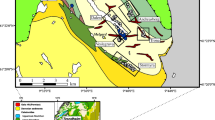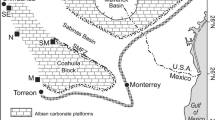Abstract
We provide here information on the distribution of copper, zinc, lead, gold, silver, barium, arsenic, antimony, mercury, selenium and tellurium in the Moore and Monte Negro high-sulfidation epithermal deposits in the Pueblo Viejo district, Dominican Republic. Moore and Monte Negro are funnel-shaped zones of advanced argillic alteration and precious-metal mineralization which extend to depths of about 350 m below the present surface. The uppermost part of the Moore deposit has been removed by erosion, whereas the Monte Negro deposit is covered by rocks containing low, but still anomalous gold grades. At Moore, concentrations of all elements except copper increase upward through the deposit. At Monte Negro, all elements except barium and zinc show a similar upward increase in concentration to a point near the top of the deposit from which they decrease upward. This difference reflects the fact that the top of the Moore deposit has been removed by erosion. Because the deposits are funnel-shaped and average metal concentrations increase by almost an order of magnitude upward, most of the metals are concentrated in the upper parts of the deposits. The upward increase in concentration of most metals is gradual and similar in magnitude to the prograde temperature dependence in solubilities of many metal complexes, suggesting that the metals were deposited by cooling. By contrast, concentrations of mercury and, to a lesser extent, tellurium increase more abruptly in the upper part of the deposits. This change probably reflects boiling of the hydrothermal solutions and partitioning of mercury and tellurium into a rising vapor phase, and it suggests that host rocks overlying the deposits will be anomalous in mercury and tellurium. Comparison to the Broadlands, New Zealand, hydrothermal system supports these inferred depositional processes. It shows that the behavior of arsenic and antimony at Broadlands was different from that at Pueblo Viejo, possibly because the elements were complexed differently in the two ore fluids. Comparison of trace-element abundances at Pueblo Viejo to other high-sulfidation epithermal systems shows differences in base-metal, arsenic and mercury abundances which may be related to the depths at which the deposits formed. The results of this study highlight the application and need for quantitative trace-element data from epithermal deposits.











Similar content being viewed by others
References
Afifi AM, Kelly WC, Essene EJ (1988) Phase relations among tellurides, sulfides and oxides II. Applications to telluride-bearing ore deposits: Econ Geol 83:395–404
Archibald SM, Migdisov AA, Williams-Jones AE (2001) The stability of Au-chloride complexes in water vapor at elevated temperatures and pressures. Geochim Cosmochim Acta 65:4413–4423
Barnes HL, Seward TM (1997) Geothermal systems and mercury deposits. In: Barnes HL (ed) Geochemistry of hydrothermal ore deposits, 3rd edn. Wiley, New York, pp 699–736
Bowin CO (1966) Geology of the Central Dominican Republic. Geol Soc Am Mem 98:11–84
Cooke DR, McPhail DC (2001) Epithermal Au-Ag-Te mineralization, Acupan, Baguio district, Philippines: numerical simulations of mineral deposition. Econ Geol 96:109–131
Cooke DR, Simmons SF (2000) Characteristics and genesis of epithermal gold deposits. In: Hagemann SG, Brown PE (eds) Gold in 2000. Rev Econ Geol 13:221–244
Fein JB, Williams-Jones AE (1997) The role of mercury-organic interactions in the hydrothermal transport of mercury. Econ Geol 92:20–28
Feiss PG (1974) Reconnaissance of the tetrahedrite-tennantite/enargite-famatinite phase relations as a possible geothermometer. Econ Geol 69:383–390
Giordano TH, Barnes HL (1979) Ore solution chemistry VI. PbS solubility in bisulfide solutions to 300 °C. Econ Geol 74:1637–1646
Haas JL (1971) The effect of salinity on the maximum thermal gradient of a hydrothermal system at hydrostatic pressure. Econ Geol 66:940–946
Hayashi K, Sugaki A, Kitakaze A (1990) Solubility of sphalerite in aqueous sulfide solutions at temperatures between 25 and 240 °C. Geochim Cosmochim Acta 54:715–725
Hedenquist JA, Matsuhisa Y, Izawa E, White HC, Giggenbach WF, Oaki M (1994) Geology, geochemistry, and origin of high sulfidation Au mineralization in the Nansatsu district, Japan. Econ Geol 89:1–30
Hemley JJ, Montoya JW, Marinenko JW, Luce RW (1980) Equilibria in the system Al2O3-SiO2-H2O and some general implications for alteration-mineralization processes: Econ Geol 75:210–228
Henley RW, Truesdell AH, Barton PB (1984) Fluid-mineral equilibria in hydrothermal systems. Rev Econ Geol 1
Hernandez PA, Garcia-Estrada PA, Cowley PN (1989) Geological setting, alteration and lithogeochemistry of the Transaccion epithermal gold deposit, Rodalquilar mining district, southeast Spain. Inst Mining Metall Trans Sect B 98:78–80
John DA, Nash JT, Clark CW, Wulftange WH (1990) Geology, hydrothermal alteration and mineralization at the Paradise Peak gold-silver-mercury deposit, Nye County, Nevada. In: Raines GL, Lisle RE, Schafer RW, Wilkinson WH (eds) Geology and ore deposits of the Great Basin. Geol Soc Nevada, Reno, pp 1020–1050
Kesler SE (1998) Geologic relations between Pueblo Viejo mineralization and the Los Ranchos Formation: the status in 1997. In: Feiss PG (ed) Mineral deposits of the Dominican Republic. SEG Fieldtrip Guideb, pp 31–36
Kesler SE, Russell N (2000) Discussion of: Nelson, C.E., Volcanic domes and gold mineralization in the Pueblo Viejo district, Dominican Republic. Miner Deposita 36:465–468
Kesler SE, Russell N, Seaward M, Rivera J, McCurdy K, Cumming GL, Sutter JF (1981) Geology and geochemistry of sulfide mineralization underlying the Pueblo Viejo gold-silver oxide deposit, Dominican Republic. Econ Geol 76:1096–1117
Kesler SE, Russell N, Polanco J, McCurdy K, Cumming GL (1991) Geology and geochemistry of the early Cretaceous Los Ranchos Formation, central Dominican Republic. In: Mann P, Draper G, Lewis JF (eds) Geologic and tectonic development of the North America-Caribbean plate boundary in Hispaniola. Geol Soc Am Spec Pap 262:187–201
Kesler SE, Russell N, Sanchez R (2003) Abundancia y zonacion de metales y bario en el depósito, ácido-sulfato (alta sulfidación) Monte Negro, distrito de Pueblo Viejo, República Dominicana. Soc Geol Peru (in press)
Kettler RM, Rye RO, Kesler SE, Meyers PA, Polanco J, Russell N (1992) Gold deposition by sulfidation of ferrous Fe in the lacustrine sediments of the Pueblo Viejo district (Dominican Republic): the effect of Fe-C-S diagenesis on later hydrothermal mineralization in a maar-diatreme complex. Chem Geol 99:29–50
Longo AA (2000) The San Jose-Careachugo-Chaquicocha gold trend, Yanacocha district, northern Peru. In: Cluer JK, Price PG, Struhsacker EM, Hardyman RF, Morris CL (eds) Geology and ore deposits 2000: the Great Basin and beyond. Geol Soc Nevada Symp Proc, 15–18 May 2000, pp 201–220
Loucks RR, Petersen U (1988) Polymetallic epithermal fissure vein mineralization, Topia, Durango, Mexico. Part II. Silver mineral chemistry and high resolution patterns of chemical zoning in veins. Econ Geol 83:1529–1559
Maske S, Skinner BJ (1971) Studies of the sulfosalts of copper. I. Phases and phase relations in the system Cu-As-S. Econ Geol 66:901–918
McCurdy K, Russell N, Kesler SE (1986) Primary dispersion of trace elements and alteration zoning at the Pueblo Viejo Au-Ag deposit, Dominican Republic. J Geochem Explor 25:259–260
Migdisov AA, Williams-Jones AE, Suleimenov OM (1999) Solubility of chlorargyrite (AgCl) in water vapor at elevated temperatures and pressures. Geochim Cosmochim Acta 63:3817–3827
Muntean JL, Kesler SE, Russell N, Polanco J (1990) Evolution of the Monte Negro acid-sulfate Au-Ag deposit, Pueblo Viejo, Dominican Republic: important factors in grade development. Econ Geol 85:1738–1758
Nelson CE (2000) Volcanic domes and gold mineralization in the Pueblo Viejo district, Dominican Republic. Miner Deposita 35:1738–1758
Peppard B (2002) Geology and geochemistry of the Ivanhoe epithermal gold-silver deposit and its overlying silicified zones. MSc Thesis, University of Michigan, Ann Arbor
Posfai M, Buseck PR (1998) Relationships between microstructure and composition in enargite and luzonite. Am Mineral 83:373–382
Russell N, Kesler SE (1991) Geology of the maar-diatreme complex hosting precious metal mineralization at Pueblo Viejo, Dominican Republic. Geol Soc Am Spec Pap 262:203–214
Russell N, Seaward M, Rivera JA, McCurdy K, Kesler SE, Cloke PL (1981) Geology and geochemistry of the Pueblo Viejo gold-silver oxide deposit, Dominican Republic. Trans Inst Mining Metall Sect B 90:25–34
Russell N, Polanco J, Kesler SE (1986) Geology of the Monte Negro gold-silver deposit, Pueblo Viejo district, Dominican Republic. In: Macdonald AJ (ed) Gold '86 Proc vol. Konsult International, Willowdale, ON, pp 497–503
Seward TM (1973) Thio complexes of gold in hydrothermal ore solutions. Geochim Cosmochim Acta 37:379–399
Shenberger DM, Barnes HL (1989) Solubility of gold in aqueous sulfide solutions from 150° to 350°C. Geochim Cosmochim Acta 53:269–278
Siddeley G, Araneda R (1986) The El Indio-El Tambo gold deposits, Chile. In: Macdonald AJ (ed) Gold '86 Proc vol. Konsult International, Willowdale, ON, pp 445–456
Sillitoe RH, Bonham HR Jr (1984) Volcanic landforms and ore deposits. Econ Geol 79:1286–1298
Simon G, Kesler SE, Essene EJ (1997) Phase relations among selenides, sulfides, tellurides and oxides. II. Applications to selenide-bearing ore deposits. Econ Geol 92:468–484
Spycher NF, Reed MH (1989) Evolution of a Broadlands-type epithermal ore fluid along alternative P-T paths: implications for the transport and deposition of base, precious, and volatile metals. Econ Geol 84:328–359
Turekian KK, Wedepohl KH (1961) Distribution of the elements in some major units of the Earth's crust. Geol Soc Am Bull 72:175–192
Vennemann TW, Muntean JL, Kesler SE, O'Neil JR (1993) Stable isotope evidence for magmatic fluids in the Pueblo Viejo epithermal acid-sulfate Au-Ag deposit, Dominican Republic. Econ Geol 88:55–71
Vikre PG (1985) Precious metal vein systems in the National District, Humboldt County, Nevada. Econ Geol Bull Soc Econ Geol 80:360–393
Williams-Jones AE, Normand C (1997) Controls of mineral paragenesis in the system Fe-Sb-O. Econ Geol 92:308–324
Wilson HDB (1944) Geochemical studies of the epithermal deposits at Goldfield, Nevada. Econ Geol 39:37–55
Wingfield R (1973) Pyrophyllite distribution and occurrence at the Pueblo Viejo gold mine. BSc Thesis, University of Toronto
Wood SA, Samson IA (1998) Solubility of ore minerals and complexation of ore metals in hydrothermal solutions. In: Richards JP, Larson PB (eds) Techniques in hydrothermal ore deposits geology. Soc Econ Geol Rev Econ Geol 10:33–80
Zakaznova-Iakovleva VP, Migdisov AA, Suleimenov OM, Williams-Jones AE, Alehjin YV (2001) An experimental study of stibnite solubility in gaseous hydrogen sulfide from 200 to 320°C. Geochim Cosmochim Acta 65:289–298
Acknowledgements
We are grateful to Rosario Dominicana and particularly Michael Seaward, who was manager of the operation, for the opportunity to work at Pueblo Viejo and for funding this research. David Cooke, Jeff Hedenquist and Noel White provided insightful and helpful reviews of an earlier version of this manuscript.
Author information
Authors and Affiliations
Corresponding author
Additional information
Editorial handling: N. White
Rights and permissions
About this article
Cite this article
Kesler, S.E., Russell, N. & McCurdy, K. Trace-metal content of the Pueblo Viejo precious-metal deposits and their relation to other high-sulfidation epithermal systems. Miner Deposita 38, 668–682 (2003). https://doi.org/10.1007/s00126-003-0356-1
Received:
Accepted:
Published:
Issue Date:
DOI: https://doi.org/10.1007/s00126-003-0356-1




